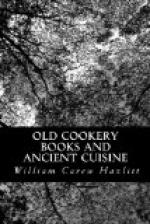When the dish was ready, it was served up with green sauce, in which the chief ingredients were sage, parsley, pepper, and oil, with a little salt. Green geese were eaten with raisin or crab-apple sauce. Poultry was to be well larded or basted while it was before the fire.
I may be allowed to refer the reader, for some interesting jottings respecting the first introduction of coal into London, to “Our English Home,” 1861. “The middle classes,” says the anonymous writer, “were the first to appreciate its value; but the nobility, whose mansions were in the pleasant suburbs of Holborn and the Strand, regarded it as a nuisance.” This was about the middle of the thirteenth century. It may be a mite contributed to our knowledge of early household economy to mention, by the way, that in the supernatural tale of the “Smith and his Dame” (sixteenth century) “a quarter of coal” occurs. The smith lays it on the fire all at once; but then it was for his forge. He also poured water on the flames, to make them, by means of his bellows, blaze more fiercely. But the proportion of coal to wood was long probably very small. One of the tenants of the Abbey of Peterborough, in 852, was obliged to furnish forty loads of wood, but of coal two only.
In the time of Charles I., however, coals seem to have been usual in the kitchen, for Breton, in this “Fantasticks,” 1626, says, under January:—“The Maid is stirring betimes, and slipping on her Shooes and her Petticoat, groaps for the tinder box, where after a conflict between the steele and the stone, she begets a spark, at last the Candle lights on his Match; then upon an old rotten foundation of broaken boards she erects an artificiall fabrick of the black Bowels of New-Castle soyle, to which she sets fire with as much confidence as the Romans to their Funerall Pyles.”
Under July, in the same work, we hear of “a chafing dish of coals;” and under September, wood and coals are mentioned together. But doubtless the employment of the latter was far less general.
In a paper read before the Royal Society, June 9, 1796, there is an account of a saucepan discovered in the bed of the river Withain, near Tattersall Ferry, in Lincolnshire, in 1788. It was of base metal, and was grooved at the bottom, to allow the contents more readily to come within reach of the fire. The writer of this narrative, which is printed in the “Philosophical Transactions,” considered that the vessel might be of Roman workman-ship; as he states that on the handle was stamped a name, C. ARAT., which he interprets Caius Aratus. “It appears,” he adds, “to have been tinned; but almost all the coating had been worn off.... The art of tinning copper was understood and practised by the Romans, although it is commonly supposed to be a modern invention.”
Neckam mentions the roasting-spit, elsewhere called the roasting-iron; but I fail to detect skewers, though they can hardly have been wanting. Ladles for basting and stirring were familiar. As to the spit itself, it became a showy article of plate, when the fashion arose of serving up the meat upon it in the hall; and the tenure by which Finchingfield in Essex was held in capite in the reign of Edward III.—that of turning the spit at the coronation—demonstrates that the instrument was of sufficient standing to be taken into service as a memorial formality.




